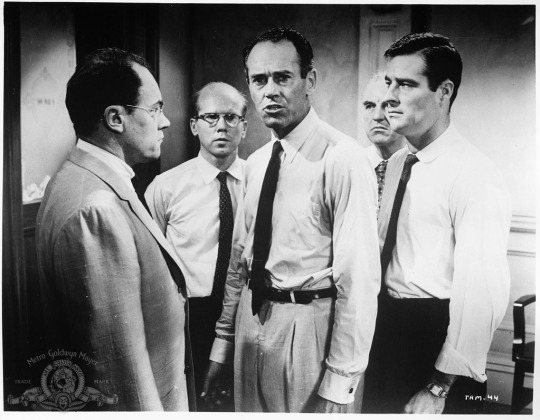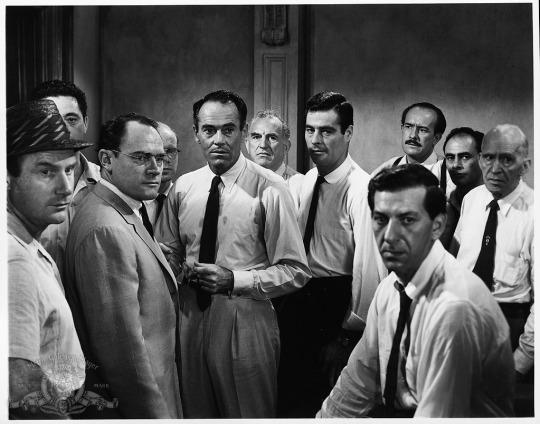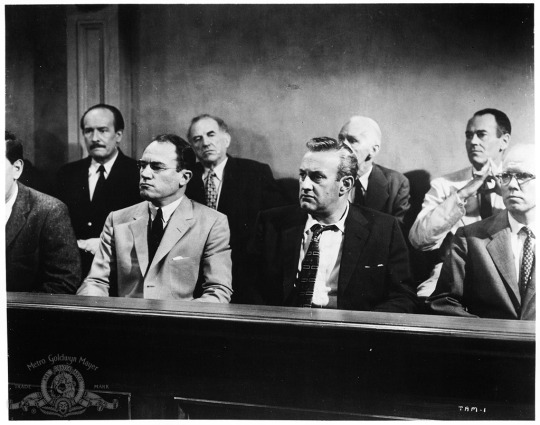#both for the creators' direct influence in future works and continued bigotry
Text
12 Angry Men: A Product of the Times
Despite what shows like Leave it to Beaver and Father Knows Best would have you believe, the 1950s in America were not a ‘simpler’ time.
The soldiers came home from World War II, the economy expanded, and the nation’s population grew and thrived, all seeming like absolute wins in our nation’s history. The suburbs grew, and the ideal nuclear families began popping up. Everyone dressed to the nines, the War was over, and so was the Depression that preceded it. America was prosperous again.
At the same time, the Korean War began. McCarthyism kicked off a terrified hysteria about the invasion of Communism. Sputnik was launched, the Cold War was off and running, and Americans lived in fear behind their white picket fences. Men went back to work, women went back to the home. Rock and roll was born, and the young people, now called teenagers, started rebelling against the conformity of their parents. Racial tensions began rising. Oppressed people across America began looking to the future for change.
This was the world when 12 Angry Men made its debut in theaters.

Why am I telling you all of this?
Simple.
In order to truly understand and analyze any work of fiction, we must first contextualize it. To do that, we have to know what the culture was like at the time.
Why?
As I’ve mentioned many times on this blog, no piece of media is an island. Everything we watch, read, or listen to is a direct product of the culture it was created in. The creators were influenced by things around them, be they other pieces of media or simply events and attitudes of the time, and as a result, the film, television show, or book is a reflection of the culture, be it critical of it or embracing of it.
Such is the case with 12 Angry Men.

The premise of a jury made up entirely of middle-to-late aged, middle-class white men passing a decision on a Puerto Rican boy from the slums seems, by its very nature, firmly set in the era of the 1950s. The attitudes of multiple jurors seems to emphasize this fact with plenty of prejudice against the defendant for his background, ethnic and otherwise, his age, and even his relationship with his father. 12 Angry Men is definitely a film that is discernibly made in an era that is behind us. To some, that would be enough to seal its doom with the ultimate stamp of disapproval any ‘old’ movie can get: the verdict of ‘Dated’.
As those of us who indulge in older films are more than aware of, sometimes, older movies just don’t hold up quite so well. When that happens, oftentimes the film is referred to as ‘dated’. Oftentimes, the things that people consider ‘outdated’ are things that can’t be helped: slang, clothing, hairstyles, special effects, technology, or even styles of storytelling that were popular at the time of the film’s release.
Therein lies the problem.
By that logic, that definition of the term dated, every single piece of media ever made is ‘dated’ and therefore, nothing is ‘timeless’. This is bad news for every creator of art who desires to make something that will outlast them. If everything is connected to the culture, the times it was created in, then nothing is worth watching outside of the era it was created in. This would lead to many classic films, television shows, and books becoming long-forgotten. Even now, there are many who don’t like watching things made before the date of their birth, claiming they are ‘cringey’ and ‘dated’.
Again, by that definition, they’re right.

Here, though, we have a different definition.
The term ‘dated’, the idea of being directly connected to the era and culture of a piece of media’s creation, is easy to forgive when the ‘datedness’ extends to a mullet, a mixtape, or a money-shot that looks a little cheesy by modern standards. However, that form of dated is not the problem.
‘Dated’ is really only used in a negative context when the movie or show it is describing is not as enjoyable to modern audiences as it was when it was released, suggesting that the passage of time has done more to damage the film than credit it. This definition of the term ‘dated’ exonerates films that have not lost the enjoyability of their core story in the years that have followed.
Being ‘dated’ is far more damaging when it is attached to outdated ideas. It is there that we have our problem.
An outdated idea can damage a film ten times more than any pop-culture reference therein. These are the films based around inherently problematic elements, that never address (and in some cases seem to promote) ideas that we now know are problems. It is this definition of ‘dated’ that we need to apply in order to tell how well 12 Angry Men has held up.

Looking past the clothes and the hair is the glaring problem of the all-white, all-male jury. Definitely an effective reminder that this film was made in the 1950s, for sure, but that could be as much a reminder of the times as it was an effect of them, for as the film tells us, there’s quite a lot of bigotry going on in 1950s America.
The only character in the film who is not explicitly Caucasian is the unnamed defendant, the Puerto Rican boy from the slums. It is his fate in the hands of the twelve men, and unfortunately, to some, his fate doesn’t seem to matter. Juror #10 notably holds the opinion that he is one of ‘them’, displaying superiority and prejudice that cannot be overlooked as ‘harmless’. During his rant on the subject at the end, he is ignored, abandoned, shut down by his fellow jurors, who are more fair-minded. As Juror #9 (Curiously, the oldest of the bunch) points out early in the film:
“Only an ignorant man can believe that…Do you think you were born with a monopoly on the truth?”
An important idea in this film is that of open-mindedness, of fairness to our fellow men. The movie stands as a jarring mirror to some of the bigoted ideas held by many in the 1950s, in more ways than one. While the film definitely has a biting opinion of those who look down on people from other backgrounds (ethnic or otherwise), there’s also an interesting look at the youth of the 1950s in the film.
The defendant is a young man, basically a boy, accused of killing his father after a fight. In the first age of teenage rebellion, Juror #3 speaks the words of parents who feel wronged by their children, while simultaneously carrying the guilt of spurning them to rebellion in the first place. The idea of making your sons into ‘men’ at age nine is treated as being a problem, driving a wedge between both father and son, a possibly irreparable one.

These themes alone would seem to date the film right away, with the heavy emphasis on ideas that were prevalent at the time, if it weren’t for the context with which the ideas are viewed.
Rather than glorify either idea, or present them as being acceptable in the culture, both of these elements are viewed critically by the narrative and the characters within it. The film, while not exonerating the rebellion of the children, acknowledges the part that parents play in it, and outright views racial prejudice with disdain. Not only was this a demonstration of progressive thinking, it’s also still relevant today.
In fact, there isn’t a whole lot about this movie that isn’t relevant today. The idea of ensuring that our justice system works is one that will likely never go out of style, and the critical mirror the film holds up to some of the ideas of 1957 holds up very well in an era where some haven’t moved too far beyond the same thinking. The film, and the ideas it was based around, still resonate with audiences who see it today, managing to leave an impression over sixty years since it’s original release.
On the other hand, there is a total lack of female characters entirely, (hence the title), leading to some remakes to add a female judge (to keep the name) or change it to 12 Angry Jurors or in some cases, 12 Angry Men and Women (In other cases, the title has been changed to 12 Angry Women.) This would seem to be the response directed at the one issue the film never addresses, that is, the lack of female representation. If anything, the lack of it makes the critical reflection all the sharper, the world of the 1950s being dominated by men in general. The absence of female presence is telling, leaving the twelve men as the focus, all with ideas that (for the most part) are familiar with one another, if not shared by each other.
In short?
12 Angry Men loses some of its enjoyability only if one has no concept of our society’s history and current climate. It was relevant in 1957, and it remains relevant today, in a culture not so far removed as we might think. As we continue to progress, 12 Angry Men will stand forever as a landmark and a reminder, no less moving now than it was over sixty years ago.
Thanks so much for reading! Remember the ask box is always open if you have any suggestions, questions, comments, or just want to say hi, and I hope to see you in the next article.
#12 Angry Men#12 Angry Men 1957#1957#50s#Film#Movies#Drama#Crime#PG#Henry Fonda#Lee J. Cobb#Ed Begley#E.G. Marshall#Jack Warden#Jack Klugman#Joseph Sweeney#George Voskovec#John Fiedler#Robert Webber#Edward Binns#Martin Balsam#Sidney Lumet
6 notes
·
View notes